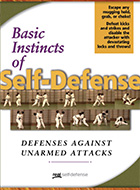Learn from others’ experience….
Real self-defense means keeping you from being a victim of crime and of law
Real self-defense is first of all about avoiding being assaulted or even bothered, about seeing trouble well ahead and not walking into an ambush, about discouraging an attack by your demeanor, and only when all else fails it is about neutralizing an attack that could not be prevented.
The “neutralizing” ought to be done in a manner that minimizes the chance of the defender being victimized by the law. What I mean is that any harm to the attacker, no matter how grave, must be the direct consequence of a purely defensive action.
Self-defense and danger of legal prosecution
Take this hint: The best defenses look like accidents and then can be explained as accidents too…. And for sure they have to be explainable, in a court of law, as actions meant solely to protect the defender and not purposefully harm the assailant. With a little practice and a cool head, anyone can turn an attack into a bad accident for the attacker.
Now, about phony self-defense: Haven’t you seen demonstrations in which a defender unfailingly intercepts an attack, say a punch, a kick, or a knife stab, and then “destroys” an attacker in blood-chilling ways, often making terrifying faces and blood-curdling screams too? Without exception the attack is prearranged, the initial defense is fake — it wouldn’t work against anyone other than a cooperating partner — and the follow-up, should it be possible, takes so long it exposes the defender to other attackers, and because it exceeds legal bounds of self-defense, exposes the defender to legal prosecution.
You must realize that fighting is not necessarily self-defense, and the best self-defense is not having to fight. Nevertheless, being a proficient fighter helps in self-defense. Good fighters are calm, relaxed, hard to upset, and thus hard to provoke and draw into a fight. Think of MMA: Good groundwork specialists are hard to take down because they are not afraid of fighting on the ground. People who are afraid of ground fighting worry about it, become tense, and are distracted by thoughts of it, and thus they are much easier to take down.
On this site you can learn techniques of real self-defense, both physical and mental, from simple moves that protect you and, if needed, incapacitate the assailant, to ways of playing with others’ minds, to discouraging assaults by influencing the lowlife to give you wide berth.
Mental toughness and physical conditioning
Important mental techniques you need to master are concentration and relaxation at will, as well as developing an emotionally detached mind-set — what I call “thinking like a commander.”
One of the tools of developing mental toughness is physical conditioning. What’s more, done correctly, physical conditioning gives a mental edge specific to self-defense. Fighters know that conditioning in itself is a weapon, not just in the physical sense but also in the mental sense. In a conflict a well-conditioned person is calmer than a poorly conditioned one, whose confidence is undermined by observing an unfazed, relaxed, unfatigued opponent. The cool confidence of the well-conditioned opponent grows as the confidence of the poorly conditioned combatant wanes…. And a calm demeanor, expressionless face, and lack of signs of stress are disconcerting to an aggressor. Here is more on the use of physical conditioning for both physical fighting prowess and mental toughness….
Law: right of self-defense, justifiable self-defense, legal provocation, and self-defense justification
“To be acquitted of any kind of physical harm-related crime (such as assault and battery and homicide) using the self-defense justification, [defendants] must prove legal provocation, meaning that [defendants] must prove that they were in a position where not using self-defense would most likely lead to death, serious injuries and property damage.”
— https://en.wikipedia.org/wiki/Self-defense
“However, when an assailant ceases to be a threat (e.g. by being tackled and restrained, surrendering, or fleeing), the defense of justification will fail if the defending party presses on to attack or to punish beyond imposing physical restraint.”
— https://en.wikipedia.org/wiki/Right_of_self-defense
For your actions to qualify as justifiable self-defense, you must be in immediate danger, and not just in your opinion but in the opinion of a “reasonable and prudent person.” Lawyers call it “imminent jeopardy.” Jeopardy can cease as soon as your attacker surrenders or ceases to be a threat, say, is restrained or tries to run away. Continuing to use force against the attacker when you are no longer in imminent jeopardy is illegal, and you will be prosecuted.

Ideal self-defense weapons are those that are legal to carry everywhere, do not attract attention, are simple to use, and do not require practice.
See our Unbreakable® Umbrellas carried by the Presidential Security Group (PSG) of the Philippines President.

The best self-defense moves are based on your natural, instinctive reactions, require little strength and limited range of motion, and are proven in fighting experience. Learn how your natural reactions can instantly defeat any unarmed attack.

To defend against weapons you have to know how they are used in an attack. Learn from an experienced street fighter how the typical street weapons (blackjack, club, knife, razor, small axe or hatchet) are used and how to practice with them.
 Staying cool under pressure is more important for self-defense than being physically fit and technically skilled. If you can’t control your mind what can you control? Learn mental techniques that let you calmly face any threat and act rationally in the heat of a fight.
Staying cool under pressure is more important for self-defense than being physically fit and technically skilled. If you can’t control your mind what can you control? Learn mental techniques that let you calmly face any threat and act rationally in the heat of a fight.For a complete list of our products, click here.



